Single parents get budget boost
Financial support for single parents will be extended in tomorrow’s federal budget with the child’s age before payment cut-off to be raised from eight to 14, while cost of living measures are expected to add up to more than $14 billion.

Photo: AAP/Mick Tsikas
Under Treasurer Jim Chalmers’ second budget to be delivered on Tuesday, parents will be able to receive $922.10 a fortnight until their youngest turns 14.
Changes in the budget will also allow for parents to no longer have to transfer to JobSeeker when their youngest turns eight.
The changes will come into effect from September 20, with eligible single parents on JobSeeker set to get a $176.90 increase in pay per fortnight.
The raise in the age cut-off will cost $1.9 billion to the federal budget through to the 2026/27 financial year.
Prime Minister Anthony Albanese said the changes to single parent payments would bring more stability.
“What that will do is to make sure that women, in particular, but also fathers in situations of raising children by themselves, can have that sense of security, that children as well can be looked after,” he said.
“We want to look after single parents because we know that the role that they play in raising their children is such a priority for them and they’re deserving of more support.”
The heavily promoted budget package will include energy price relief, expected to flow to 5.5 million households and one million businesses.
Investments in cheaper medicines and tax incentives for electrification and energy efficiency upgrades will also fall under the total $14.6b over four years, targeting acute cost-of-living pressures.
More government plans to support households and businesses through the period of sky-high inflation will be unveiled in the budget on Tuesday night.
Jobseekers will be looking for a boost to income support payments following reports the government has locked in a $40-a-fortnight boost.
The latest reports follow speculation last week that any uplift would be limited to over-55s.
The Greens have already taken aim at the possibility of a $40-a-fortnight increase that would equate to a “paltry” extra $2.85 a day.
The government has also managed to find $17.8b in budget savings and shifted spending, with the finance minister accusing the former coalition government of “tricky budgeting tactics and dishonesty”.
The savings include $7.8b in re-prioritisations already outlined as part of the Defence Strategic Review.
Finance Minister Katy Gallagher said the cost of living relief was a “significant package” in scale and reach.
“This is a very strong budget in terms of support for vulnerable Australians … to investing in the future and also putting the budget on a more sustainable footing going forward,” she said.
Asked about the reprioritisation of money, Gallagher said the government’s approach had not been to “slash, cut and burn” but to target funding to address future needs and pressures.
Changes to the petroleum resources rent tax have also been announced that, if enshrined into legislation, would bring in an extra $2.4b over four years.
What we know so far
– Potential for a slim budget surplus, given the underlying cash balance for the 12 months to March was $1.034 billion.
– Treasury says persistent deficits of about two per cent of GDP are projected. The deficit for 2022/23 was $11.2 billion at the end of March, against the October budget prediction of $33.4 billion.
– Government debt is just under $900 billion, with an expected interest bill of $110 billion over five years.
– Treasury expects a 0.75 per cent increase in real wages in 2023/24, reflecting the combination of rising wages and falling inflation.
– Growth to slow to 1.25 per cent in 2023/24 as cost-of-living pressures and rising interest rates increasingly weigh on consumption.
SPENDING
– $14.6 billion package of cost-of-living measures.
– Extra defence spending following AUKUS submarines deal and strategic review.
– $3 billion in energy bill relief, including deals with each of the states and territories. This will be helped by the gas market intervention which Treasury expects to ease price rises to 18 per cent and four per cent over two years (rather than 20 per cent in both years).
– Aged care budget to rise from $24.8 billion to $29.6 billion, with the figure hitting $35.8 billion by 2025/26.
– 15 per cent pay rise for aged care workers at a cost of $11.3 billion over four years.
– Child Care Subsidy to cost $55.31 billion over four years.
– $535.3 million towards the nine National Collecting Institutions – such as the National Library and National Gallery of Australia – over four years.
– $163.4 million for the Australian Institute of Marine Science.
– Medicines changes – from September 1, general patients will be able save up to $180 a year if their medicine is able to be prescribed for 60 days, concession card holders will save up to $43.80 a year per medicine.
– $2.2 billion for Medicare reforms, including incentives for after-hours doctors.
– $737 million for programs to deal with harm caused by tobacco and vaping products.
– Extra $262.3 million for national parks, including Uluru.
– $3.7 billion extra for the five-year National Skills Agreement, taking total spending to $12.8 billion.
– $2 billion for more social and affordable housing via the National Housing Finance and Investment Corporation.
– $400 million for defence force retention bonuses.
– Funding for the new National Anti-Corruption Commission and a standalone privacy commissioner.
-Review of $120 billion infrastructure project list.
TAX
– $3.3 billion increase in tobacco taxes over three years, to pay for health programs.
– Offshore LNG industry to pay petroleum resources rent tax revenue sooner, increasing tax receipts by $2.4 billion over four years.
– Multinational tax avoidance crackdown continues.
– Commodity price estimates to be upgraded, having been set at a very conservative $55 a tonne for iron ore.
– Income and company tax receipts to be higher than expected.
-with AAP




